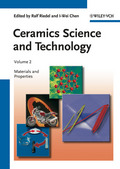Ceramics Science and Technology
Volume 2: Materials and Properties

1. Edition April 2010
XXVI, 862 Pages, Hardcover
399 Pictures (63 Colored Figures)
58 tables
Handbook/Reference Book
Short Description
Ceramics have progressed from ancient bulk materials in pottery, construction, and decoration to a multitude of modern applications requiring thermal and chemical stability, durability and resistance to wear in environments and conditions under which other material classes cannot serve adequately. Ceramics Science and Technology illuminates this exciting material class from all sides for a wide audience ranging from materials scientists and engineers to chemists, biochemists, physicists and medical researchers.
Although ceramics have been known to mankind literally for millennia, research has never ceased. Apart from the classic uses as a bulk material in pottery, construction, and decoration, the latter half of the twentieth century saw an explosive growth of application fields, such as electrical and thermal insulators, wear-resistant bearings, surface coatings, lightweight armour, or aerospace materials. In addition to plain, hard solids, modern ceramics come in many new guises such as fabrics, ultrathin films, microstructures and hybrid composites.
Built on the solid foundations laid down by the 20-volume series Materials Science and Technology, Ceramics Science and Technology picks out this exciting material class and illuminates it from all sides.
Materials scientists, engineers, chemists, biochemists, physicists and medical researchers alike will find this work a treasure trove for a wide range of ceramics knowledge from theory and fundamentals to practical approaches and problem solutions.
PART I: Ceramic Material Classes
CERAMIC OXIDES
Introduction
Aluminum Oxide
Magnesium Oxide
Zinc Oxide
Titanium Dioxide
Zirconium Oxide
Cerium Oxide
Yttrium Oxide
NITRIDES
Silicon Nitride
Boron Nitride
Aluminum Nitride
Titanium Nitride
Tantalum Nitride
Chromium Nitride
Ternary Nitrides
Light-Emitting Nitride and Oxynitride Phosphors
GALLIUM NITRIDE AND OXONITRIDES
Introduction
Gallium Nitrides
Gallium Oxides
Gallium Oxonitrides
Outlook
SILICON CARBIDE- AND BORON CARBIDE-BASED HARD MATERIALS
Introduction
Structure and Chemistry
Production of Particles and Fibers
Dense Ceramic Shapes
Properties of Silicon Carbide- and Boron Carbide-Based Materials
Applications of Carbides
COMPLEX OXYNITRIDES
Introduction
Principles of Silicon-Based Oxynitride Structures
Complex Si-Al-O-N Phases
M-Si-Al-O-N Oxynitrides
Oxynitride Glasses
Oxynitride Glass Ceramics
Conclusions
PEROVSKITES
Introduction
Crystal Structure
Physical Properties
Chemical and Catalytic Properties
THE Mn+1AXn PHASES AND THEIR PROPERTIES
Introduction
Bonding and Structure
Elastic Properties
Electronic Transport
Thermal Properties
Mechanical Properties
Tribological Properties and Machinability
Concluding Remarks
PART II: Structures and Properties
STRUCTURE-PROPERTY RELATIONS
Introduction
Self-Reinforced Silicon Nitrides
Fibrous Grain-Aligned Silicon Nitrides (Large Grains)
Fibrous Grain-Aligned Silicon Nitrides (Small Grains)
Grain Boundary Phase Control
Fibrous Grain-Aligned Porous Silicon Nitrides
DISLOCATIONS IN CERAMICS
Introduction
The Critical Resolved Shear Stress
Crystallography of Slip
Dislocations in Particular Oxides
Work Hardening
Solution Hardening
Closing Remarks
DEFECT STRUCTURE, NONSTOICHIOMETRY, AND NONSTOICHIOMETRY RELAXATION OF COMPLEX OXIDES
Introduction
Defect Structure
Oxygen Naonstoichiometry
Nonstoichiometry Re-Equilibration
INTERFACES AND MICROSTRUCTURES IN MATERIALS
Introduction
Interfaces in Materials
Practical Implications
Summary and Outlook
PART III: Mechanical Properties
FRACTURE OF CERAMICS
Introduction
Appearance of Failure and Typical Failure Modes
A Short Overview of Damage Mechanisms
Brittle Fracture
Probabilistic Aspects of Brittle Fracture
Delayed Fracture
Concluding Remarks
CREEP MECHANISMS IN COMMERICAL GRADES OF SILICON NITRIDE
Introduction
Material Characterization
Discussion of Experimental Data
Models of Creep in Silicon Nitride
Conclusions
FRACTURE RESISTANCE OF CERAMICS
Introduction
Theory of Fracture
Toughened Ceramics
Influence of Crack Growth Resistance Curve Upon Failure by Fracture
Determination of Fracture Resistance
Fatigue
Concluding Remarks
SUPERPLASTICITY IN CERAMICS: ACCOMMODATION-CONTROLLING MECHANISMS REVISITED
Introduction
Macroscopic and Microscopic Features of Superplasticity
Nature of the Grain Boundaries
Accommodation Processes Superplasticity
Applications of Superplasticity
Future Prospective in the Field
PART IV: Thermal, Electrical, and Magnetic Properties
THERMAL CONDUCTIVITY
Introduction
Thermal Conductivity of Dielectric Ceramics
High-Thermal Conductivity Nonoxide Ceramics
Mechanical Properties of High-Thermal Conductivity Si3N4 Ceramics
Concluding Remarks
ELECTRICAL CONDUCTION IN NANOSTRUCTURED CERAMICS
Introduction
Space Charge Layers in Semiconducting Ceramic Materials
Effect of Space Charge Profiles on the Observed Conductivity
Influence of Nanostructure on Charge Carrier Distributions
Case Studies
Conclusions and Observations
FERROELECTRIC PROPERTIES
Introduction
Intrinsic Properties: The Anisotrophy of Properties
Extrinsic Properties: Hard and Soft Ferroelectrics
Textured Ferroelectric Materials
Ferroelectricity and Magnetism
Fatigue in Ferroelectric Materials
MAGNETIC PROPERTIES OF TRANSITION-METAL OXIDES: FROM BULK TO NANO
Introduction
Properties of Transition Metal 3d Orbitals
Iron Oxides
Ferrites
Chromium Dioxide
Manganese Oxide Phases
Concluding Remarks
I-Wei Chen is currently Skirkanich Professor of Materials Innovation at the University of Pennsylvania since 1997, where he also gained his master's degree in 1975. He received his bachelor's degree in physics from Tsinghua University, Taiwan, in 1972, and earned his doctorate in metallurgy from the Massachusetts Institute of Technology in 1980. He taught at the University of Michigan (Materials) during 1986-1997 and MIT (Nuclear Engineering; Materials) during 1980-1986. He began ceramic research studying martensitic transformations in zirconia nano crystals, which led to work on transformation plasticity, superplasticity, fatigue, grain growth and sintering in various oxides and nitrides. He is currently interested in nanotechnology of ferroelectrics, thin film memory devices, and nano particles for biomedical applications. A Fellow of American Ceramic Society (1991) and recipient of its Ross Coffin Purdy Award (1994), Edward C. Henry Award (1999) and Sosman Award (2006), he authored over 90 papers in the Journal of the American Ceramic Society (1986-2006). He also received Humboldt Research Award for Senior U.S. Scientists (1997).


